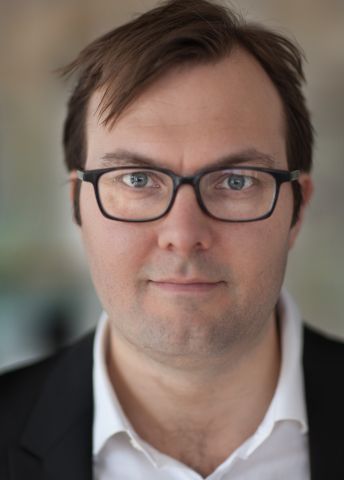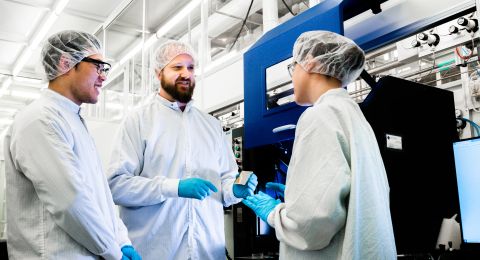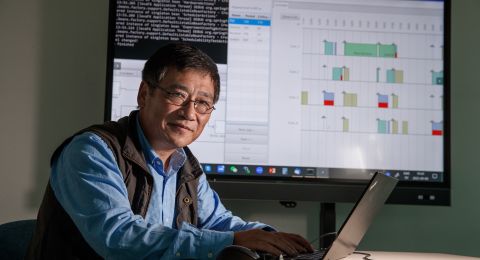The sun’s rays are a renewable energy source offering huge potential. Kasper Moth-Poulsen is developing a promising new concept using artificial molecules that can capture, store and release solar energy, so that it can be used when the sun is not shining.
Kasper Moth-Poulsen
Professor in nano materials chemistry
Wallenberg Academy Fellow 2014
Institution:
Chalmers University of Technology
Research field:
Conversion of solar energy into chemical energy in molecules
New technology that can make use of solar energy efficiently and cheaply is in demand throughout the world. Development is driven by climate change, and society’s huge need for renewable technology.
“These are very exciting times for researchers in this field. Hopefully, our technology can be developed quickly enough to contribute to current progress in this area,” Kasper says.
At present solar energy cannot be stored. It has to be used straight away, when the sun is shining. This is a big problem, particularly in our cooler northern climes. The technology being developed by Kasper and his team will enable solar energy to be used when and where it is needed.
“Traditional technology uses solar cells and a battery, but we are trying to create an integrated single unit. Our concept MOST – Molecular Solar Thermal – converts solar energy into chemical energy, which is stored in specially designed molecules. When we need the energy, we can trigger the molecules to release it, so that it can be used to heat buildings, for example, or be converted into electricity.”
An idea born in California
Kasper studied chemistry at University of Copenhagen, and then took a PhD in Molecular Electronics. Some years later, in sunny California, when he was a postdoc at the University of California, Berkeley, he began work on thermal energy storage. When Kasper moved to Chalmers University of Technology in 2011, he brought with him the idea of storing solar energy in molecules to be developed by his own research team. The technology is now being further developed with funding from the Knut and Alice Wallenberg Foundation.
“The grant gives us the courage to try somewhat riskier projects, with a slightly longer timeframe. I can have a larger research team, which has an enormous impact on the kind of issues we can address. A large grant of this kind is also a form of recognition and gives me greater confidence as a researcher.”
“Together with researchers at UC Berkeley we have conducted experiments showing that we can store and release solar energy using the same molecules. This is in fact an old concept from the 1970’s that has gained new impetus in recent years. Using the potential offered by new computer technology, we are better able to design molecules and understand how they work.”
Kasper mentions that the results, which were published in 2012, attracted much international attention. Last year his research team made another important breakthrough when they showed they could improve the efficiency of storage and energy conversion by these molecules.

The research team has grown from three to 15 people in two years. This in itself is a challenge for a young research leader, but with more researchers, he will also be able to address bigger and more difficult issues. Kasper believes that the interdisciplinary environment at Chalmers offers particularly good prospects for success for a project of this kind.
“I am a chemist, but I work a lot with physicists, including Paul Erhart here in the same corridor, who is also a Wallenberg Academy Fellow. He calculates our molecules, and makes quantum mechanical computer models of how they should work. Then we test them.”
A nano catalyst
Kasper explains that the idea is for it to be possible to reuse the same molecules over and over again. The entire process takes place in a closed system without harmful environmental impacts in the form of emissions of carbon dioxide or chemicals.
“The research we are doing is not just about developing a new molecule; it covers the whole process from storage to release of the energy.”
One challenge the team faces is to improve the absorption of solar energy by the molecule, to make use of as much sunlight as possible. The silicon-based solar cells on the market convert only up to about 32 percent of sunlight into energy. Kasper is aiming for greater efficiency.
“We are also making strenuous efforts using nanotechnology to develop a catalyst that will help to release the stored energy. It is a long process, but we have recently found a new catalyst that seems to work.”
The higher the temperature of the thermal energy extracted from the molecules, the more potential applications there will be.
“At the moment we are achieving about 50°C, but we would really like to go much further than that – to 100°C or more. We’ll have to see how far we get.”

Interest from industry
Molecules and nano catalysts are being developed in the chemistry lab on the same floor as Kasper’s office. Here there is also a technology lab in which the researchers carry out demonstrations of the energy storage concept. They start with very simple experiments using solar lamps that illuminate the liquid with the molecules. At the moment a class of molecules called norbornadienes are being tested.
“Over the next five years we hope to be able to move from basic research to more realistic demonstrations of the concepts.”
The solar power industry has already shown interest in the technology. But Kasper wants to make some more progress before entering into definite collaborations.
“Although this is pure basic research, we hope that when the project is over in 5 – 10 years, we will have come a good way along the road towards future niche applications. Step by step, depending on how successful we are, we will hopefully be able to identify potential of various kinds.”
Text Susanne Rosén
Translation Maxwell Arding
Photo Magnus Bergström





